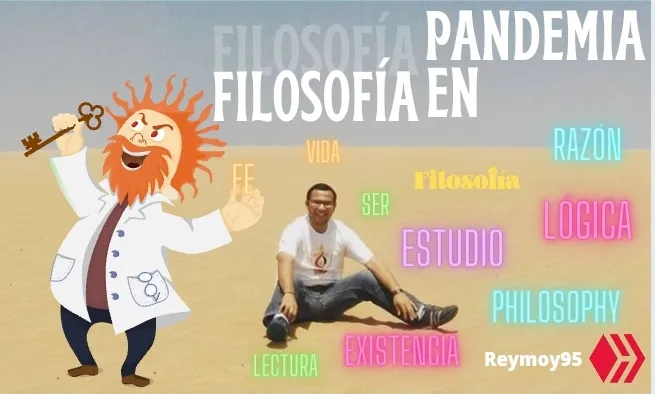
Fuente: Imagen realizada en canva
Es de interés observar dentro del texto sobre “qué es la metafísica” de Heidegger su estructura, a simple vista por el título pareciera que el autor va directo a la respuesta de su interrogante, no obstante, cuando llegamos a la lectura entendemos que el autor primero nos coloca ante un problema metafísico para luego así dar respuesta al texto escrito y en especial a su título. De esta forma, creo que el texto ha sido escrito en un modo experiencial, es decir, Heidegger ante la interrogante del problema metafísico, encuentra el problema materializado en la sociedad, por tal motivo ve como una muy buena vía para llegar a explicar, la experiencia, el contacto metafísico de la persona con el ente, o lo que la cosa es.
Así pues, tiene una estructura muy tradicional en donde se plantea el problema y luego la respuesta al problema planteado. Es importante además dejar en claro que desde el principio Heidegger quiere que el problema se responda a sí mismo “Es la sola manera de ofrecer realmente a la metafísica la posibilidad de presentarse a sí misma” (Heidegger). Por tal motivo el interés e ímpetu del planteamiento mismo en la que destaca su alcance, puesto que según lo que el plantea el problema metafísico va abrazar o alcanzar su totalidad, así pues, no hay nada que se encuentre determinado sino es por la universalidad y por el contacto del ente mismo.
It is of interest to observe within the text on "what is metaphysics" of Heidegger its structure, at first sight by the title it seems that the author goes directly to the answer of his question, nevertheless, when we arrive to the reading we understand that the author first places us before a metaphysical problem to then give answer to the written text and especially to its title. In this way, I believe that the text has been written in an experiential way, that is to say, Heidegger before the questioning of the metaphysical problem, finds the problem materialized in the society, for such reason he sees as a very good way to come to explain, the experience, the metaphysical contact of the person with the entity, or what the thing is.
Thus, it has a very traditional structure where the problem is posed and then the answer to the problem posed. It is also important to make clear that from the beginning Heidegger wants the problem to answer itself "It is the only way to really offer metaphysics the possibility of presenting itself " (Heidegger). For this reason the interest and impetus of the approach itself in which emphasizes its scope, since according to what he raises the metaphysical problem will embrace or reach its totality, thus, there is nothing that is determined but by the universality and by the contact of the entity itself.

Fuente: Imagen realizada en canva
Hay una existencia dentro de la ciencia imposible de acabar, de ignorar y Heidegger lo plantea bajo una tríada, siendo esta “referencia universal, actitud, irrupción” (Heidegger) para el autor estos 3 dan la noción y la calidez de presencia y la manifestación de lo universal es el hombre mismo quien toma una posición frente al ente y es capaz de intervenir. Desde entonces, bajo la tríada de Heidegger el problema metafísico va floreciendo porque él considera que no hay posibilidad de abandonar el ente o de dejar de descubrirlo, puesto que si dejo de hacer lo estaría admitiendo, por tal razón estaría entrando en la metafísica ¿Qué cosa es?
Por consiguiente, para el autor no hay dentro de su pensar filosófico un abandonar de la nada y aprovecha la oportunidad para hacer una crítica a la ciencia la cual de una forma hostil la desprecia y la tiene por menos dentro de sus estudios. Sin embargo, Heidegger nota que al ella querer abandonarla más bien la invoca, ya que al no querer saber nada de la nada admite la existencia de ella, desde entonces, el autor en su estudio indaga sobre este problema y se descubre una poderosa arma dentro del conocimiento, y es que “el entendimiento es el medio y el pensar es el camino para captar originariamente la nada y decidir acerca de su posible revelación” (Heidegger)
There is an existence within science impossible to end, to ignore and Heidegger raises it under a triad, being this "universal reference, attitude, irruption " (Heidegger) for the author these 3 give the notion and the warmth of presence and the manifestation of the universal it is man himself who takes a position in front of the entity and is able to intervene. Since then, under Heidegger's triad the metaphysical problem is flourishing because he considers that there is no possibility of abandoning the entity or of ceasing to discover it, since if I stop doing it I would be admitting it, for such a reason I would be entering metaphysics What is it?
Therefore, for the author there is not within his philosophical thinking an abandonment of nothingness and he takes the opportunity to make a criticism of science which in a hostile way despises it and considers it as less within his studies. However, Heidegger notes that by wanting to abandon it, he invokes it, since in not wanting to know anything about nothingness he admits its existence, since then, the author in his study investigates this problem and discovers a powerful weapon within knowledge, and it is that "understanding is the means and thinking is the way to originally grasp nothingness and to decide about its possible revelation" (Heidegger).

Fuente: Imagen realizada en canva
Con esto se abre paso al descubrir de la nada, entonces ¿Qué es la nada? Para el autor “Es la negación de la universalidad del ente, el no-ente absoluto” (Heidegger). Con esto, a simple vista podemos entender entonces que la nada y lo universal se enfrentan, están en posición de lucha porque lo que para una es, para la otra es la negación de aquello que es, por tanto, también es. Es paradójico quizás pensarlo de esta forma, pero no cuando el pensamiento, el pensar es quien lo revela, cuando se encuentra determinado por una operación o razón humana.
Ahora bien, ¿el hombre conoce en su totalidad la nada? Es una pregunta dentro del plano metafísico a la que en sinceridad hay que responder que no, el hombre conoce en primer lugar la palabra y en segundo su negación como sustento o mejor como el concepto de la palabra, de hecho, Heidegger lo deja en vista “alcanzamos, ciertamente, el concepto formal de la nada imaginada, pero nunca la nada misma” (Heidegger). Otro factor fundamental que se presenta ante la nada y en la que el autor no podía dejar de hablar marcado por el existencialismo es la angustia, éste piensa que ella pone de manifiesto la nada, y es interesante puesto que el desarrollo que se plantea es que la angustia aleja al ente y al alejarlo el hombre se nubla y vienen a él pensamientos de la negación, es decir, al hombre preguntarse, indagar, automáticamente hay una inclinación a aquello que es y no es.
With this opens the way to the discovery of nothingness, then What is nothingness? For the author "It is the negation of the universality of the entity, the absolute non-entity" (Heidegger). With this, at first glance we can understand then that nothingness and the universal confront each other, they are in a position of struggle because what for one is, for the other is the negation of that which is, therefore, it also is. It is paradoxical perhaps to think of it in this way, but not when thought, thinking is the one who reveals it, when it is determined by a human operation or reason.
Now then, does man know in its totality the nothingness? It is a question within the metaphysical plane to which in sincerity it is necessary to answer that no, man knows in the first place the word and secondly its negation as sustenance or better as the concept of the word, in fact, Heidegger leaves it in view "we reach, certainly, the formal concept of the imagined nothingness, but never the nothingness itself"(Heidegger). Another fundamental factor that appears before the nothingness and in which the author could not stop speaking marked by existentialism is the anguish, he thinks that it reveals the nothingness, and it is interesting since the development that arises is that the anguish distances the entity and by distancing it man is clouded and thoughts of negation come to him, that is to say, when man wonders, investigates, automatically there is an inclination to that which is and is not.

Fuente: Imagen realizada en canva
Por último, veamos entonces algunas de las respuestas planteadas por Heidegger al problema metafísico. Ante todo, es importante entonces decir que el hombre sufre transformaciones y al este estar sujeto a, también se encuentra sensible para hacer una abstracción de la nada, la angustia no es la comprensión de la nada, sino una manifestación de ella, la nada no aniquila al ente, es ante todo una negación, en donde coloca la existencia frente al ente, es decir hace cuestionarlo, es por eso, que Heidegger pone de manifiesto “existir significa mantenerse en el interior de la nada” es decir, hay una lucha entre la nada, la existencia y el ente y donde son necesarios para dar respuesta y la existencia el encubrirse se hace más que trascendente porque no hay una dependencia que la haga quedar sujeta a aquello o esto. Por otro lado, hay que tener presente que la nada, no requiere del ente como ya lo hemos dicho y que por tal cuestión ha de ser una manifestación del hombre.
Finalmente, ¿qué es la metafísica? Aunque variables han sido sus conceptos, Heidegger pone de manifiesto el trascendental a su problema en cuestión, puesto que para él descubrir o intentar desarrollar la nada hubo un proceso de entendimiento y una razón que tuvo que mirar más allá de lo planteado, así mismo es la metafísica, es ir más allá, es indagar acerca del ente, y Heidegger plantea la nada como una cuestión metafísica para decirnos que aunque no es ser, es un problema no resuelto, donde la ciencia lo aleja y se desentiende, ahora bien, lo que sí es de provecho saber es que “la nada esta manifiesta en el fondo de la existencia” (Heidegger) y por tanto se encuentra inmersa en la naturaleza y al estar dentro de ella se rodea de “el acontecimiento fundamental EN la existencia y EN CUANTO a la existencia” (Heidegger) es por esto, que se hace un problema no resuelto, es decir, un problema netamente metafísico.
Finally, let us see then some of the answers raised by Heidegger to the metaphysical problem. First of all, it is important then to say that man undergoes transformations and being subject to, he is also sensitive to make an abstraction of nothingness, anxiety is not the comprehension of nothingness, but a manifestation of it, nothingness does not annihilate the entity, it is above all a negation, where it places existence in front of the entity, that is to say, it makes question it, that is why Heidegger shows "to exist means to remain inside the nothingness" that is to say, there is a fight between the nothingness, the existence and the entity and where they are necessary to give answer and the existence the concealment becomes more than transcendent because there is not a dependence that makes it be subject to that or this. On the other hand, it is necessary to keep in mind that nothingness does not require the entity as we have already said and that for this reason it must be a manifestation of man.
Finally, what is metaphysics? Although his concepts have been variable, Heidegger shows the transcendental to his problem in question, since for him to discover or try to develop the nothingness there was a process of understanding and a reason that had to look beyond what was raised, so is metaphysics, it is to go beyond, it is to inquire about the entity, and Heidegger raises the nothingness as a metaphysical question to tell us that although it is not being, it is an unresolved problem, where science distances and ignores it, now, what is useful to know is that "nothingness is manifested in the background of existence" (Heidegger) and therefore it is immersed in nature and being within it is surrounded by "the fundamental event IN existence and AS existence" (Heidegger) is for this reason, that it becomes an unresolved problem, that is to say, a purely metaphysical problem.

Fuente: Imagen realizada en canva
Traducción al Inglés desde Deepl.com
English translation from Deepl.com
Fuente: Análisis filosófico del ensayo de Heidegger ¿Qué es la metafísica?
Philosophical analysis of Heidegger's essay What is metaphysics?
